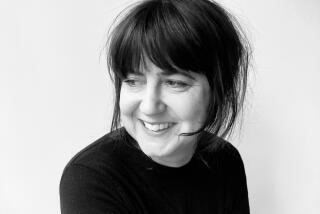Jean Rhys: Tossed about on an uneasy sea
- Share via
The Blue Hour
A Life of Jean Rhys
Lilian Pizzichini
W.W. Norton: 384 pp., $30
Most writers aren’t nearly as interesting as readers might imagine. Jean Rhys, though, was not like most writers. She was painfully shy when sober and dangerously unhinged when not; the story of her three marriages is marked by frequent moves to more and more obscure corners of England, hand-to-mouth existence and bone-chilling outbursts of rage against her spouses.
Even the usual moments of life-changing drama take on extra bulk with Rhys, as Lilian Pizzichini notes in “The Blue Hour: A Life of Jean Rhys.” After all, Rhys enjoyed the mythical “unexpected discovery” not once but twice. The first time was in Paris in 1922, when as a penniless 32-year-old expat with an infant daughter, she hawked the journalistic skills of her then-husband, Jean Lenglet -- a shady figure whose dealings in the currency market would shortly land him in jail -- only to see her own diary, a record of extravagant living and (more frequently) desperate survival in London, Paris, Vienna and Budapest, find its way to Ford Madox Ford. He landed her translation work, taught her to distill her writing and get rid of the melodrama, published the results in his journal Transatlantic Review alongside Hemingway and Gertrude Stein and told her to change her name from Ella Lenglet to the “more modern” Jean Rhys.
The second rediscovery began to take shape 25 years later, in suburban Beckenham, England, when Rhys noticed an advertisement in the New Statesman looking for her on behalf of an actress staging a BBC reading of her 1939 novel, “Good Morning, Midnight.”
Rhys was thought to be dead, but she was living, precariously, the town drunk in constant squabbles with her neighbors and with her third husband, Max. The news that she was alive reached the ears of a sympathetic publisher who in 1958 signed her to finish the novel she was working on. When her masterpiece, “Wide Sargasso Sea,” was published in 1966, and her four previous novels returned to print, she was hailed as the great lost writer of prewar England -- indeed, one of the finest and most original writers of the century.
Readers of “The Blue Hour” may feel a double sense of déjà vu over these stories of redemption. The first -- including her affair with Ford and her torturous relationship with him and his then-wife, Stella Bowen -- Rhys mined, like so many of her experiences, as material for a novel, the roman à clef “Quartet.” The second was exhaustively told by Carole Angier in her acidic 1991 Rhys biography, although by then, it was already literary lore.
Rhys’ novels and stories are, of course, fictions, but to a remarkable extent they are drawn from her life, picked out of the diaries and journals she kept of an exceedingly messy and difficult existence. Yet Pizzichini seems to recognize the pickle this creates for a biographer and manages to present a compelling and appreciative portrait that makes terrific use of the material Rhys, Angier and others have already laid out in full view.
Born Ella Gwendolen Rees Williams in 1890 to a white Creole woman and a Welsh doctor on the small Caribbean island of Dominica, Rhys left home at 17. Arriving in Southampton, England, Pizzichini tells us, “she knew so little of the world that when she stood with her aunt on the platform she did not realize the great brown thing in front of her was a train.”
She didn’t last at the Perse School in windy Cambridge and enrolled instead at the Academy of Dramatic Arts in 1909, where one desultory year prepared her for the dead-end career of a chorus girl touring the backwaters of England. She was cold and sick and ferociously lonesome. The first of her many rescuers, a stockbroker appropriately named Lancelot Grey Hugh Smith, provided an escape, only to dispatch her with a letter (and a check) from his lawyer, precipitating a dangerously despairing spiral. She worked as a masseuse and briefly as a prostitute and thought about suicide.
Rhys marvelously narrated these painful years of angered hopelessness in her 1934 novel, “Voyage in the Dark,” where the dreamlike suffocation of London is counterposed by the sharp memories of frangipani-scented Dominica and the longing for a past that could exist only in her head. The experience of exile is rendered with naked clarity -- there seems to be no gap between the experience of her protagonist, Anna Morgan, and the writer constructing her story. “She could not voice her feelings,” Pizzichini writes. “She often found that when she told people her story, they looked at her with disbelief in their eyes. So she stopped telling them. Instead, she told it to herself in her novels. . . . As a writer, this strategy worked well for her; as a woman, it did not.”
Pizzichini displays great compassion for Rhys, who disappeared into slothful, small-town existence after the soggy reception of “Good Morning, Midnight,” another bleak story that few wanted to read in England on the brink of war. As Pizzichini puts it: “Jean was ahead of her times in terms of subject matter, and contemporary in the atmosphere of impending catastrophe that she had created. Perversely, she was out of step with her readers and the modern world. It was too much information. Too much reality.”
Pizzichini seems bored by Rhys’ post-”Wide Sargasso Sea” life as an irascible demi-celebrity (nightclub impresario George Melly compared her to a septuagenarian Johnny Rotten in a pink wig). But her book -- more a “portrait” of Rhys than a full-blown biography -- largely achieves its aim: to “present the fact of Rhys’s life in such a way that the reader is left with an impression of what it was like to have lived such a life.”
In other words, it’s a fittingly and fascinatingly Rhysian approach.
Banks is former editor in chief of Bookforum.
More to Read
The biggest entertainment stories
Get our big stories about Hollywood, film, television, music, arts, culture and more right in your inbox as soon as they publish.
You may occasionally receive promotional content from the Los Angeles Times.










